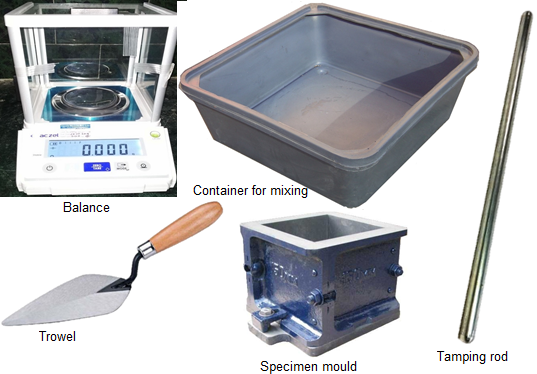Compressive strength is characterised as a material’s resistance to failure when subjected to compressive forces. Compressive strength, especially for concrete, is a critical parameter for determining the material’s efficiency under service conditions. A concrete blend should be engineered or proportioned to meet the structural engineer’s requirements for engineering and reliability properties. Additionally, reinforced concrete has engineering properties such as elastic modulus, tensile strength, creep coefficients, density, and coefficient of thermal expansion. Thus, the compressive strength test is crucial in civil engineering.

The compressive strength of concrete cubes offers information on many of the material’s properties. By this particular measure, one can determine whether or not the concrete work was completed properly. Concrete compressive strength ranges between 15 MPa (2200 psi) and 30 MPa (4400 psi) for general construction and higher for commercial and industrial structures.
The compressive strength of concrete is determined by a variety of factors, including the water-cement ratio, cement strength, the composition of the concrete content, and quality control during the concrete manufacturing process.

Compressive strength is determined using either a cube or a cylinder. Numerous model codes suggest using a concrete sphere or cube as the test specimen. ASTM C39/C39M is a Standard Test Method for Compressive Strength of Cylindrical Concrete Specimens published by the American Society for Testing Materials.
Table of Contents
Compressive Strength Definition
Compressive strength refers to a material’s or structure’s ability to support pressures on the surface without cracking or deflection. Compression tends to compact material, while stress tends to elongate it. The compressive strength of concrete is known technically as the characteristic strength of 150mm cubes of concrete after 28 days.
Formula for Compressive Strength
For any material, the compressive strength formula, used in the compressive strength test also, is the load imposed at the point of failure divided by the cross-section region of the face on which the load was applied.

Importance of Compressive Strength
Concrete, as we all remember, is a combination of sand, asphalt, and aggregate. The compressive strength of concrete is determined by a number of factors, including the composition of the materials used, the proportions of air entrainment in the mix, the water-cement ratio, curing processes, and temperature effects.
Compressive strength provides insight into the total strength and the reasons listed previously. Through performing this test, one can easily determine the concrete strength in pounds per square inch (psi) and the consistency of the concrete made.
Read Also:
Types of Foundations Used in Building Construction, their Selection Criteria and basic requirements
Is it possible to predict Earthquakes? If yes, HOW? Read in Details…
Gabion: Definition, Types, Advantages, and Applications (With Real Site Photos)
Factors affecting Compressive Strength of Concrete
Coarse Aggregate
Concrete is mixed thoroughly by the addition of aggregates, asphalt, sand, water, and a variety of other admixtures. However, even with proper mixing, microcracks can form due to variations in the thermal and mechanical properties of coarse aggregates and cement matrix, resulting in concrete failure.
Concrete technologists developed scientific ideas around aggregate size, with aggregate size being the primary factor affecting compressive power. Thus, increasing the overall size results in an improvement in compressive power.
This hypothesis was later abandoned, when research demonstrated that increasing the size of aggregates initially increased intensity but then decreased exponentially. The sole cause for this decrease in strength was the decreased surface area available for bonding between the cement matrix and aggregates, as well as a weaker transition region.
Air Entrainment
One of the concepts created by cold countries to avoid harm caused by freezing and thawing was air entrainment in concrete. Later, as experimentation demonstrated the multifaceted advantages of air entrainment, including increased workability of concrete at a lower water/cement ratio.
As achieving the optimal workability at a lower water content aided in the production of concrete with a higher compressive strength, resulting in lighter concrete with a higher compressive strength.
Ratio of Water to Cement
We are both well aware of the detrimental effects of extra water on the strength of concrete. Cement, as the primary binding material in concrete, requires water for hydration, although this is limited to about 0.20 to 0.25 percent of the cement content. Excess water proves useful in terms of improving the workability and finish of concrete.
Excess water is considered detrimental because when the water in the concrete matrix dries, it leaves vast interstitial gaps between the aggregate and cement grains. During compressive strength testing of concrete, this interstitial space transforms into main cracks.
Why we measure concrete for 7, 14, and 28 days?
At 28 days, concrete reaches its full pressure. Since a large amount of money is at stake in the building industry, we will check strength in terms of concrete strength psi (or, in N/mm2) at 7 and 14 days to forecast the target strength of construction activity. As seen in the below table, concrete gains 16 per cent of its strength within 24 hours of casting, but 65 per cent of its target strength after seven days.
After 14 days, concrete reaches 90% of the target strength; thereafter, the rate of strength gain slows, and it takes 28 days to reach 99 percent of the target strength. Concrete’s strength cannot be determined until it becomes stable. Additionally, we can not wait 28 days to determine if the concrete is appropriate for building or not; in order to maintain a balanced system, concrete is measured at different intervals.
Since the optimum strength increase occurs at 14 days, we measure concrete at periods of 7 days, 10 days, and 14 days. If the concrete does not achieve 90% of its total strength at 14 days, the batching is refused.
Compressive Strength of Concrete at Different Ages
| Age in Days | Percentage of Strength |
| 1 Day | 16% |
| 3 Days | 40% |
| 7 Days | 65% |
| 14 Days | 90% |
| 21 Days | 94% |
| 28 Days | 99% |
Compressive Strength of Various Grades of Concrete at 7, 14 and 28 Days:
| Concrete Grade | 7 Days | 14 Days | 28 Days |
| M10 | 6.5 | 9 | 10 |
| M15 | 9.75 | 13.5 | 15 |
| M20 | 13 | 18 | 20 |
| M25 | 16.25 | 22.5 | 25 |
| M30 | 19.5 | 27 | 30 |
| M35 | 22.75 | 31.5 | 35 |
| M40 | 26 | 36 | 40 |
| M45 | 29.25 | 40.5 | 45 |
| M50 | 32.5 | 45 | 50 |
Procedure of Cube Test
For the cube test or compressive strength test of concrete, either cubes measuring 15cm x 15cm x 15cm or cubes measuring 10cm x 10cm x 10cm are used, based on the overall dimension. Cubical moulds of 15cm x 15cm x 15cm are often used for the majority of the works.
This concrete is poured into the mould and properly tempered to ensure that no voids exist. Molds are discarded after 24 hours and research specimens are immersed in water to cure. These specimens’ top surfaces should be even and smooth. This is accomplished by applying cement paste and smoothing it over the whole surface of the specimen.
Compression testing is performed on these specimens after seven or twenty-eight days of curing. Gradually increase the load at a rate of 140 kg/cm2 per minute before the specimens malfunction. The compressive strength of concrete is calculated by dividing the load at failure by the region of the specimen.

The procedure for compressive strength test of concrete cubes is as follows:
Apparatus
Compression testing machine
As per IS: 516-1959, Compressive testing machine (2000KN),15cm×15cm×15cm steel cube molds or Cylinder having Dia 15cm and length 30cm are used.
Concrete Cube Specimen Preparation
The proportions and materials used to build these test specimens are identical to those used in the field.
Specimen
6 @ 15 cm cubes M15 or greater

Concrete Mixing for the Cube Test
Hand-mix the concrete or use a laboratory batch mixer.
- Combine the cement and fine aggregate on a watertight, non-absorbent platform when well combined and uniform in colour.
- Combine the coarse aggregate with the cement and fine aggregate until the coarse aggregate is spread evenly in the sample.
- Add water and continue mixing until the concrete appears homogeneous and the desired quality is achieved.
Cubes for Test Sampling
- Clean and oil the mounds.
- Fill the moulds with concrete in nearly 5-cm-thick layers.
- Each layer should be compacted with at least 35 strokes per layer using a tamping rod (steel bar 16mm diameter and 60cm long, bullet-pointed at lower end).
- With a trowel, level and smooth the top rim.
Cube Curing
After 24 hours of storage in damp air, the specimens are labelled and separated from the moulds and held immersed in transparent freshwater until removed prior to the examination.
Precautions for Tests
The water for curing should be tested every 7 days and the temperature of the water must be at 27+/- 2˚C.
Concrete Cube Test Procedure
- After the specified curing period has passed, remove the specimen from the water and clean away any excess water on the surface.
- Calculate the specimen’s dimensions to the nearest 0.2m
- Clean the testing machine’s bearing board.
- Place the specimen in the process in such a way that the load is applied to the cube cast’s opposite sides.
- Align the specimen centrally on the machine’s base plate.
- Gently rotate the movable section by hand until it reaches the specimen’s top surface.
- Gradually and consistently apply the load at a rate of 140 kg/cm2/minute before the specimen fails.
- Take notice of the full load and any odd characteristics of the type of failure.
Read Also:
Gabion: Definition, Types, Advantages, and Applications (With Real Site Photos)
Calculations of Compressive Strength Test

Similar calculation should be done for 28 day compressive strength.
Maximum load applied =……….tonnes = ………….N
Compressive strength = (Load in N / Area in mm2)=……………N/mm2
Don’t miss this:
Download All Useful Civil Engineering Formulae Collection
Results of Compressive Strength Test
Average compressive strength of the concrete cube = ………….N/mm2 (at 7 days)
Average compressive strength of the concrete cube =………. N/mm2 (at 28 days)
Thank You for reading Compressive Strength Test of Concrete i.e. Cube Test.
If you have any queries and suggestions please email us at civilengineeringmagic@gmail.com.
You can also text us in our Social Media by going to following link as:
Also, you can follow our own Constructionsmagix for construction related contents.

